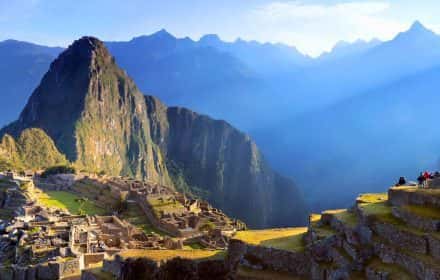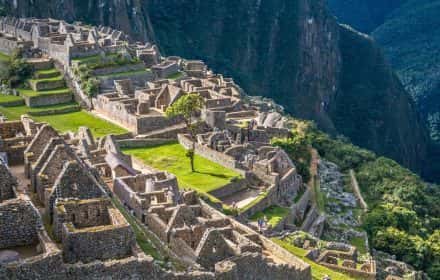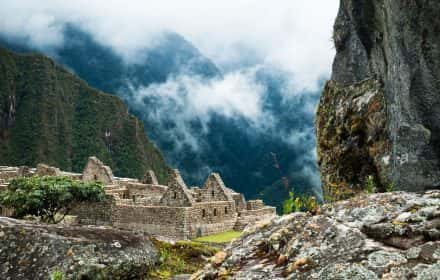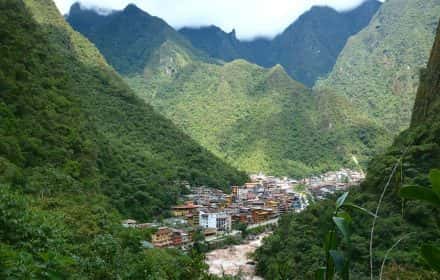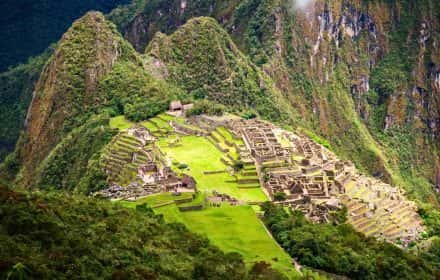This site uses affiliate links, meaning that if you make a purchase through our links, we may earn an affiliate commission.
Welcome to the ancient ruins of Machu Picchu, a UNESCO World Heritage site nestled in the Andes Mountains of Peru. This awe-inspiring archaeological wonder, often referred to as the “Lost City of the Incas,” is a testament to the advanced engineering and artistic prowess of the Inca civilization that thrived over 500 years ago.
If you are a curious adventurer looking to immerse yourself in the rich history and breathtaking landscapes of Machu Picchu, a self-guided tour may be the perfect option for you.
In this post, I will delve into the wonders of a self-guided Machu Picchu tour, where you have the freedom to explore at your own pace, soak in the mystical atmosphere, and uncover the secrets of this ancient citadel.
From planning your trip to navigating the trails, I will provide you with essential tips and insights to make your self-guided Machu Picchu tour an unforgettable experience. So grab your backpack, lace up your hiking boots, and get ready to embark on an adventure of a lifetime!
- 1. Best Time to Visit Machu Picchu
- 2. How to Get to Machu Picchu
- 3. How And Where to Buy Tickets to Machu Picchu
- 4. What Are the Opening Hours of the Machu Picchu Site
- 5. How Long Does It Take to Do Self-Guided Machu Picchu Tour
- 6. What To Pack for Machu Picchu
- 7. What You Need to Know About Machu Picchu Before You Visit
- 8. Self-Guided Machu Picchu Tour (Exploring 11 Marvels at the Mystical Citadel)
-
- 8.1. The Guardhouse
- 8.2. The Agricultural Terraces
- 8.3. The Main Gate
- 8.4. The Temple of the Sun
- 8.5. The Royal Tomb
- 8.6. The Temple of the Three Windows
- 8.7. The Principal Temple of Machu Picchu
- 8.8. Intihuatana
- 8.9. The Temple of Condor
- 8.10. The Urban Sector
- 8.11. The Main Plaza
- 9. Intrepid Scout's Tips on Self-Guided Machu Picchu Tour
Best Time to Visit Machu Picchu
The best time of the year to visit Machu Picchu is during the dry season, which is from late April through early October.
During the dry season, you will mostly get clear blue skies and nice, warm weather.
However, a word of caution, even during the dry season, which is the best time to visit Machu Picchu, you need to be prepared for some heavy mists or fog (usually during early morning hours) that can obscure the views.
Needless to say, between late April through early October, expect lots of visitors to Machu Picchu. It will be impossible to find any kind of solitude at Machu Picchu Inca ruins. Actually, you will have some difficulty moving through the Sanctuary. You need to have a lot of patience and reserve additional time for your visit.
If you would rather skip the crowds and do not mind some occasional showers, then plan for the months of March or November.
How to Get to Machu Picchu
One of the most convenient ways to reach Machu Picchu without hiking is by taking the train and then a bus.
There are two train companies available: the PeruRail and the Inca Rail.
The train journey takes you through breathtaking landscapes of the Andes Mountains and lush valleys, providing a scenic and comfortable ride to Machu Picchu.
The train ride itself is an adventure, with large windows that allow you to soak in the panoramic views while enjoying onboard amenities.
Be prepared to book your train tickets at least 6-4 months in advance to secure the best departure and arrival times, as well as be able to select the train class that is the best for your budget.
How And Where to Buy Tickets to Machu Picchu
My recommendation is to buy tickets in advance and online through the official website of the Peru Ministry of Culture: Ministerio de Cultura del Peru. The process of buying entrance tickets through the website of the Peru Ministry of Culture is a little confusing. Make sure to read my post before you attempt to buy the tickets. It will save you a lot of time!
There are plenty of other websites that sell tickets to Machu Picchu. However, be cautious! Before you make a purchase make sure that these are legitimate places and check their prices. They are re-sellers so most likely, you are going to have to pay extra.
What Are the Opening Hours of the Machu Picchu Site
Machu Picchu is open every day of the year (including Sundays and holidays). The opening hours are from 6 am to 5:30 pm.
The best time of the day to visit Machu Picchu is either early morning or late afternoon. The hordes of tourists start arriving at about 11 am and hang out at Machu Picchu till about 3 pm.
My recommendation is to plan for being at Machu Picchu at sunrise. It is truly magical.
How Long Does It Take to Do Self-Guided Machu Picchu Tour
You need a minimum of 3-4 hours to just see the highlights of the Machu Picchu City of the Incas. However, my recommendation is to spend a day at Machu Picchu the City of the Incas!
What To Pack for Machu Picchu
- Passport and Entrance Ticket to Machu Picchu – Your passport and your entrance ticket are two of the most important items that you need to remember to pack with you for a day trip to Machu Picchu! First of all, you will not be able to enter the site if you do not have your passport. Second, your name, as it appears on your passport, must match the name that is listed on the ticket.
Besides, at the end of your visit, as a souvenir, make sure to get a stamp on your passport.
- Camera – Don’t forget your camera. And, charge the batteries beforehand or bring extra batteries with you.
Unfortunately, tripods are not allowed at the Machu Picchu site.
- Cash – If you are going to use a locker to store your luggage, then you will need cash to pay for the locker. By the way, large backpacks are not permitted in Machu Picchu, all you can take with you is a daypack.
Also, there is a restaurant it is more like a snack bar, at the entrance to Machu Picchu, if you choose to get something to eat there, then you will need cash.
Apparently, you cannot bring food with you inside Machu Picchu Inca ruins. Although, I have seen plenty of tourists snacking on the food they brought with them. Play it by ear, if you are asked to throw away your snacks, so be it. If you manage to bring something to snack on, then be discreet about it and do not litter.
Also, right at the entrance, there are bathrooms. There is a small charge for using the bathrooms. And, yes, make sure to make a trip to the bathroom, because there are no bathrooms at the Machu Picchu site.
- Water – Make sure to bring water with you! Remember that water in plastic bottles is not allowed. However, you can fill up a reusable, non-plastic container and take that in with no problem. Trust me, you will need water. You will be outside in the full sun for several hours, so water is essential.
- Insect Repellent – Insect repellent is a must. So get it and carry it with you everywhere and spray like crazy. I do not think there are a lot of mosquitoes at that elevation, however, be prepared for sand flies. I am not an epidemiologist, so I do not know what kind of sandflies these are. But, consider yourself warned! They are flying, biting, blood-sucking dipterans.
In addition, make sure to wear long pants, socks up to your knees, and a long sleeve shirt.
- Sun Protection – There is no shade at the Machu Picchu site. The entire time you will be in the sun (weather permitting), so make sure to protect yourself. First of all, layer on some sunblock, wear a hat, long pants, and a long sleeve shirt.
- Proper clothing – First of all, the weather at Machu Picchu can be unpredictable, so be prepared. It is very cold in the morning (dry season), and then it warms up and gets to be very hot during the day. So, dress in layers. Next, be prepared for occasional showers, so bring a poncho. Finally, good, sturdy, waterproof shoes are a must.
What You Need to Know About Machu Picchu Before You Visit
- Machu Picchu is an ancient Inca city located in the Andes Mountains of Peru, South America. It is situated on a mountain ridge at an altitude of 2,430 meters (7,970 feet) above sea level and was built in the 15th century.
- The ruins of Machu Picchu include well-preserved temples, palaces, and terraced fields, which are believed to have been used for agricultural purposes. The site also features a sophisticated water management system, which is still functional today.
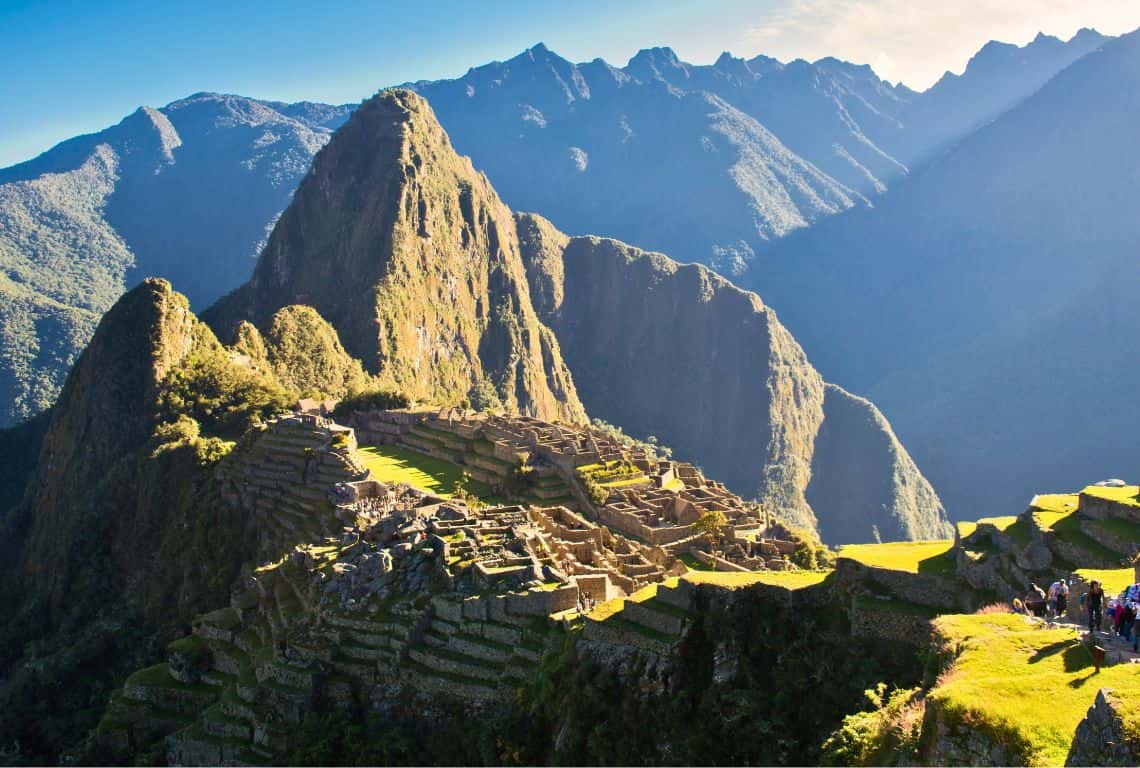
Machu Picchu, the Lost City of the Incas / Self-Guided Machu Picchu Tour
- Why did the Incas select this location? I am sure it was not just for the breathtaking views. Machu Picchu sits much lower than the nearest city of Cusco, making it warmer than the capital city of the Incas. In addition, the Urubamba River helped with the irrigation and sanitation at the site.
- The building of Machu Picchu was carefully planned and executed. For example, a research excavation found that the rock and soil foundations of the terraces go nine feet below the ground. They are layered with stone chips, sand, dirt, and topsoil, to absorb water and prevent mudslides, landslides, soil erosion, and flooding. Similar layering protected the large city center from flooding. Multiple canals and reserves throughout the city provided water that could be supplied to the terraces for irrigation and to prevent erosion and flooding.
- Machu Picchu was built atop two fault lines. The walls of the structures have many stabilizing features. For example, the doors and windows are trapezoidal, narrowing from bottom to top.
- The central buildings use the classical Inca architectural style of polished dry-stone walls of regular shape. The Incas were masters of this technique, called ashlar, in which blocks of stone are cut to fit together tightly without mortar.

The Incas were masters of the technique called ashlar, in which blocks of stone are cut to fit together tightly without mortar / Self-Guided Machu Picchu Tour
- Interestingly, the Incas never used wheels in a practical way. The use of wheels in engineering may have been limited due to the lack of strong draft animals, combined with steep terrain and dense vegetation.
- The approach to moving and placing the enormous stones remains uncertain, probably involving hundreds of men to push the stones up inclines. A few stones have knobs that could have been used to lever them into position; the knobs were generally sanded away, with a few overlooked.
- It is estimated that about 750 people lived at Machu Picchu. Besides the royal court, the majority of the people who resided at Machu Picchu were servants, however, it is believed that there were religious specialists as well as skilled workers.
- Archaeologists discovered that most of the servants who lived at Machu Picchu were immigrants from different areas. Information gathered from the analysis of their bones proves that some were from the coastal areas and their initial diets were composed of corn, potatoes, grains, and fish, while their later diet included mostly corn.
- Machu Picchu City was used for approximately 80 years before being abandoned. Why Machu Picchu was abandoned remains a mystery. Some theories suggest that it was due to the Spanish Conquest in other parts of the Inca Empire. Some hypotheses indicate that it is possible that most of Machu Picchu’s inhabitants died from smallpox brought by the Spanish conquistadors.
- Machu Picchu is often called the Lost City of the Incas. The Incas built the estate around 1450 and abandoned it a century later at the time of the Spanish conquest. Even though Machu Picchu was located only about 80 kilometers (50 mi) from the Inca capital in Cusco, the Spanish never found it. It remained undiscovered for almost four centuries. Its location and inaccessibility saved Machu Picchu from plunder and destruction by the Spanish conquistadors. Over the centuries, the surrounding jungle overgrew the site.
- American historian Hiram Bingham brought Machu Picchu to international attention in 1911. Hiram Bingham traveled the region looking for the old Inca capital and was led to Machu Picchu by a villager, Melchor Arteaga.
- However, Bingham was not the first one to discover Machu Picchu. The name Agustín Lizárraga and the date 1902 were written in charcoal on one of the walls. However, Bingham is considered the scientific discoverer who brought Machu Picchu to international attention.
- In 1912 Bingham organized another expedition to undertake major clearing and excavation.
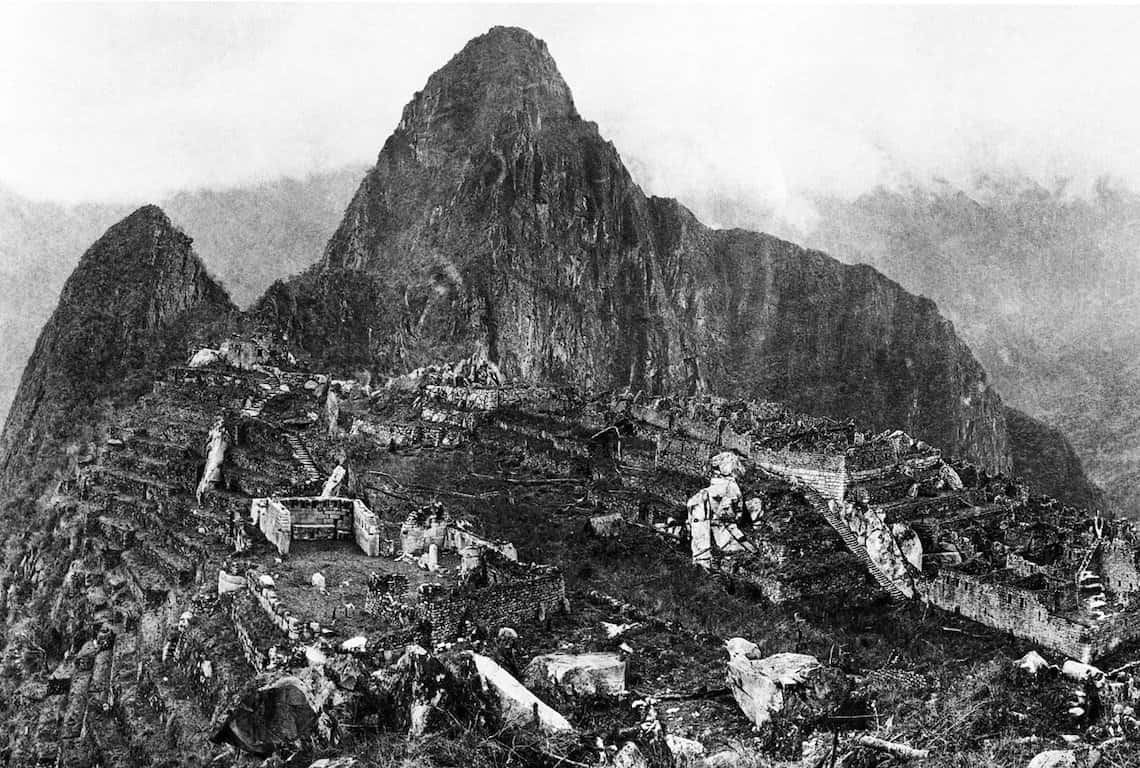
American historian Hiram Bingham brought Machu Picchu to international attention in 1911/ Image Credit: Wikipedia / Self-Guided Machu Picchu Tour
- In 1981, Peru declared an area of 325.92 square kilometers (125.84 sq miles) surrounding Machu Picchu a “historic sanctuary”. In 1983, UNESCO designated Machu Picchu a World Heritage site, describing it as “an absolute masterpiece of architecture and a unique testimony to the Inca civilization”.
Self-Guided Machu Picchu Tour (Exploring 11 Marvels at the Mystical Citadel)
The site is roughly divided into an urban sector and an agricultural sector and into an upper town and a lower town.
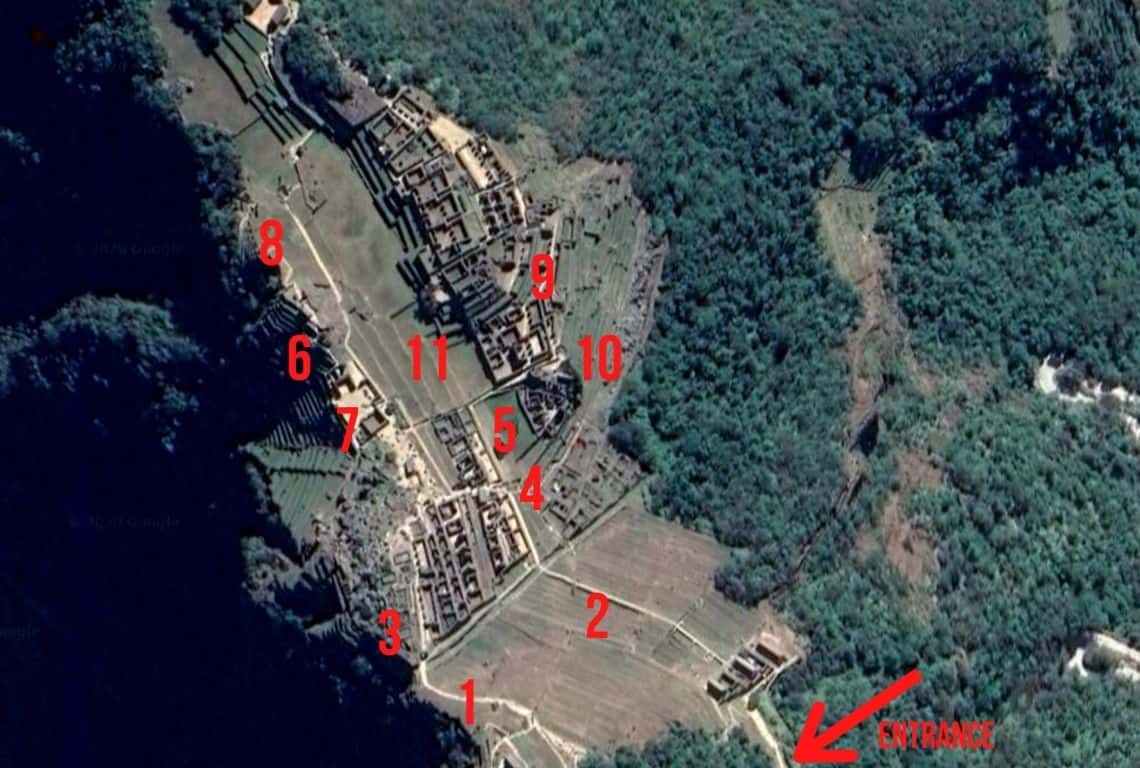
Map of Machu Picchu / Self-Guided Machu Picchu Tour
1. Guardhouse
2. Agricultural Terraces
3. The Main Gate
4. The Temple of the Sun
5. The Royal Tomb
6. The Temple of the Three Windows
7. The Principal Temple
8. Intihuatana
9. The Temple of Condor
10. The Urban Sector
11. The Main Plaza
The Guardhouse
The Guardhouse, also known as the Caretaker’s Hut, is a small stone building located on the western edge of the citadel. It is situated on a rocky outcrop and offers panoramic views of the Machu Picchu Site, and the surrounding mountains, including the famous peak of Huayna Picchu.
It is believed that the Guardhouse served as a control point for those entering and leaving the site.
The architecture of the Guardhouse is typical of the Inca style, with precision-cut stones carefully fitted together without the use of mortar. This technique of fitting stones together without the use of mortar is known as “ashlar masonry” and is one of the defining features of Inca architecture. It is said that the stones are so finely fitted together that a single blade of grass cannot fit between them.
The building features a trapezoidal shape, with a sloping roof and a central doorway that is flanked by two windows. The three-sided style of Inca architecture is known as the wayrona style.
The windows are positioned to provide a wide view of the surrounding area, allowing the guards stationed at the building to keep a watchful eye on anyone entering or leaving the site.
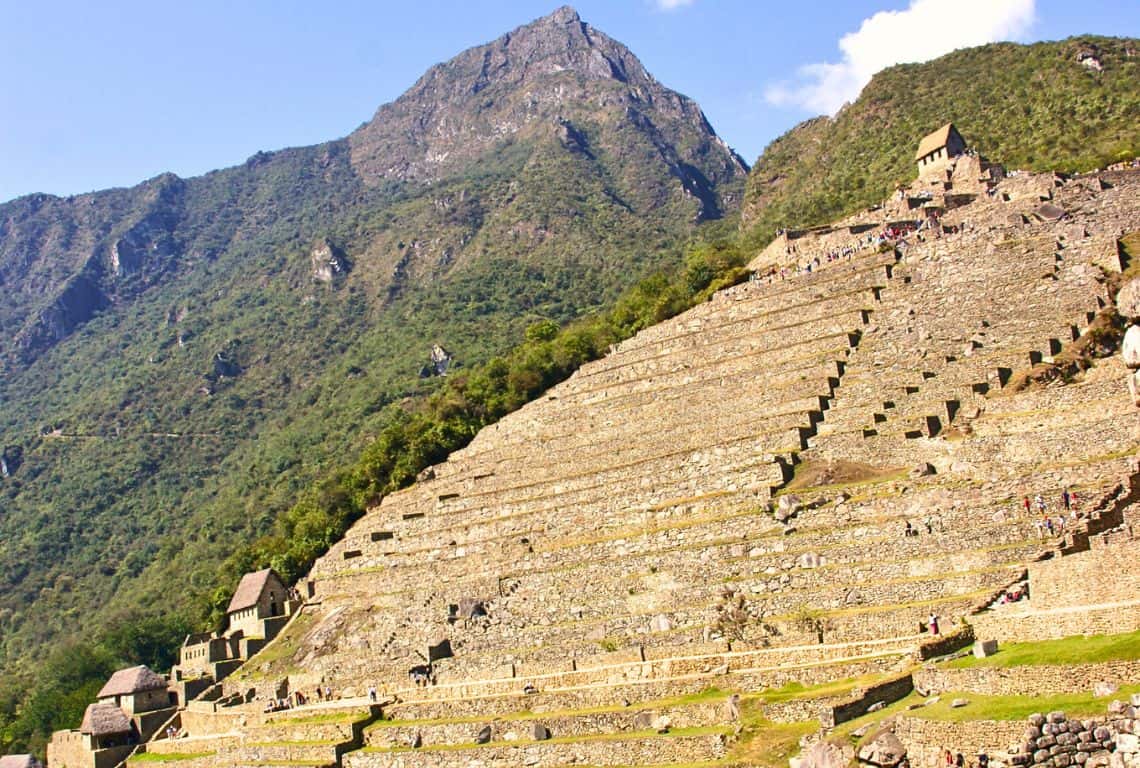
The Guardhouse at Machu Picchu / Self-Guided Machu Picchu Tour
The Agricultural Terraces
The agricultural area at Machu Picchu was an essential part of the site’s infrastructure and was vital to sustaining the inhabitants of the citadel.
The agricultural terraces were built into the steep mountainside using impressive stonework and a sophisticated system of irrigation. The technique is called “andenería”. It involved building retaining walls from stone to create flat, stepped surfaces on the mountainside. The walls were built using a combination of large and small stones and were designed to withstand the steep incline of the mountain.
The agricultural terraces at Machu Picchu were irrigated using a complex system of channels and aqueducts that brought water from nearby springs. The channels and aqueducts were also built using stone, and they were designed to channel water to the terraces in a controlled manner.
The crops grown on the agricultural terraces at Machu Picchu included maize, potatoes, quinoa, and other vegetables and fruits.
The terraces were arranged in a way that allowed for the cultivation of multiple crops at different elevations, taking advantage of the microclimates created by the varying elevations and exposures.
The Inca used a variety of techniques to fertilize the soil in the agricultural terraces, including the use of guano (bird droppings), which is rich in nitrogen, and llama manure. They also practiced crop rotation and intercropping, which involved planting different crops together in order to maximize the use of nutrients in the soil.
The construction and maintenance of the agricultural terraces at Machu Picchu required a significant amount of labor. It is believed that the labor and resources were provided to the Inca state as part of a system of tribute and labor obligations.

Agricultural Terraces / Self-Guided Machu Picchu Tour
The Main Gate
The Main Gate at Machu Picchu is believed to be the main entrance to the Incan city.
It is a simple but impressive structure that is built from large blocks of granite. The gate is trapezoidal in shape and is framed by two large stone pillars.
The gate was designed to be easily defended, with a narrow doorway that could be easily blocked by soldiers or other defenders if needed.
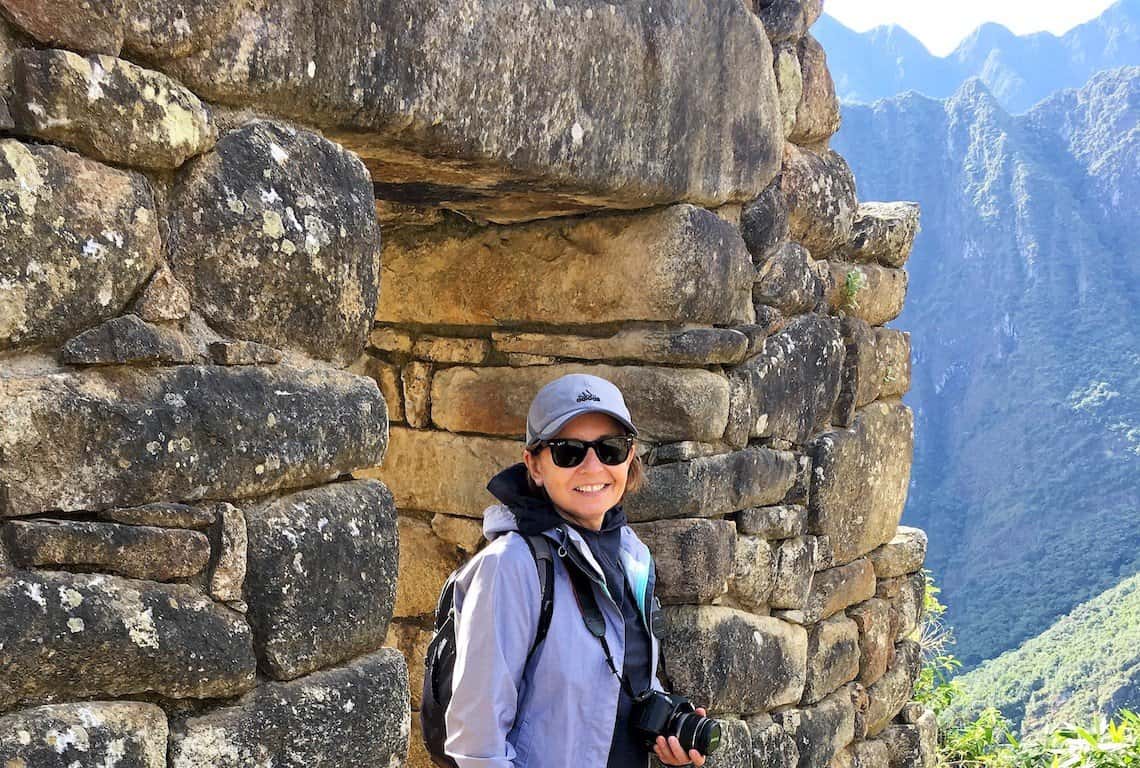
The Main Gate / Self-Guided Machu Picchu Tour
The Temple of the Sun
The Temple of the Sun is believed to have been one of the most important religious and ceremonial buildings in the city, and it is characterized by its unique architecture and intricate stonework.
It is the only building in Machu Picchu Inca city with a rounded wall.
The most notable feature of the Temple of the Sun is its central chamber, which is believed to have been a place of great spiritual importance for the Incan people. Inside is a granite slab, carved from the rock beneath. It could have been used as an altar.
The chamber has a trapezoid window called the Solstice Window. During the winter solstice, the sun shines directly through the window and illuminates the central chamber, and casts its rays on the granite slab.
This is believed to have been an important astronomical event for the Incan people, who used the movement of the sun and stars to determine important dates for planting crops, holding religious ceremonies, and other activities.
The Temple of the Sun is also believed to have been a place of great spiritual power, and it was likely used for important religious ceremonies and offerings.
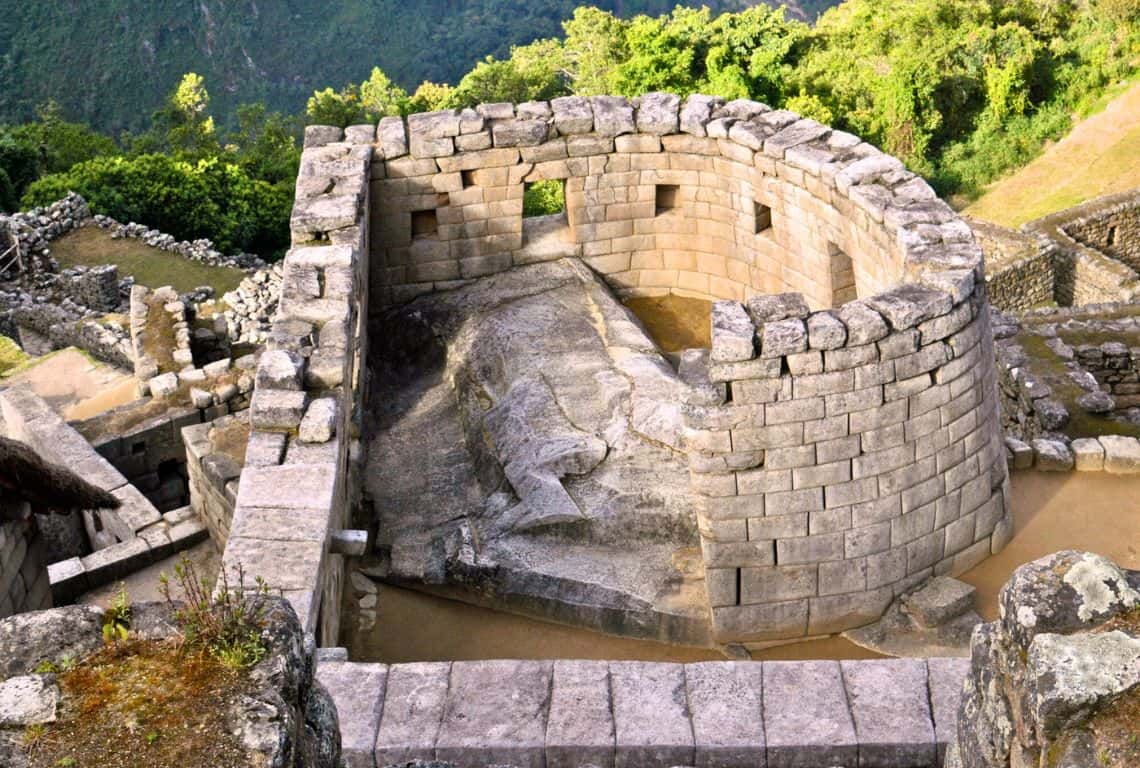
The Temple of the Sun / Self-Guided Machu Picchu Tour
The Royal Tomb
The Royal Tomb is a cave with beautifully carved step motifs, full of niches with superb stonework. It is an example of the best stonework at Machu Picchu Inca city.
Although Hiram Bingham found no human remains inside the cave, the quality of work led him to name it a royal tomb.
Despite extensive archaeological research and exploration of Machu Picchu, no evidence of a royal tomb or burial site has been found at the site. The purpose and function of the various structures within Machu Picchu are still the subjects of ongoing research and debate among archaeologists and scholars.
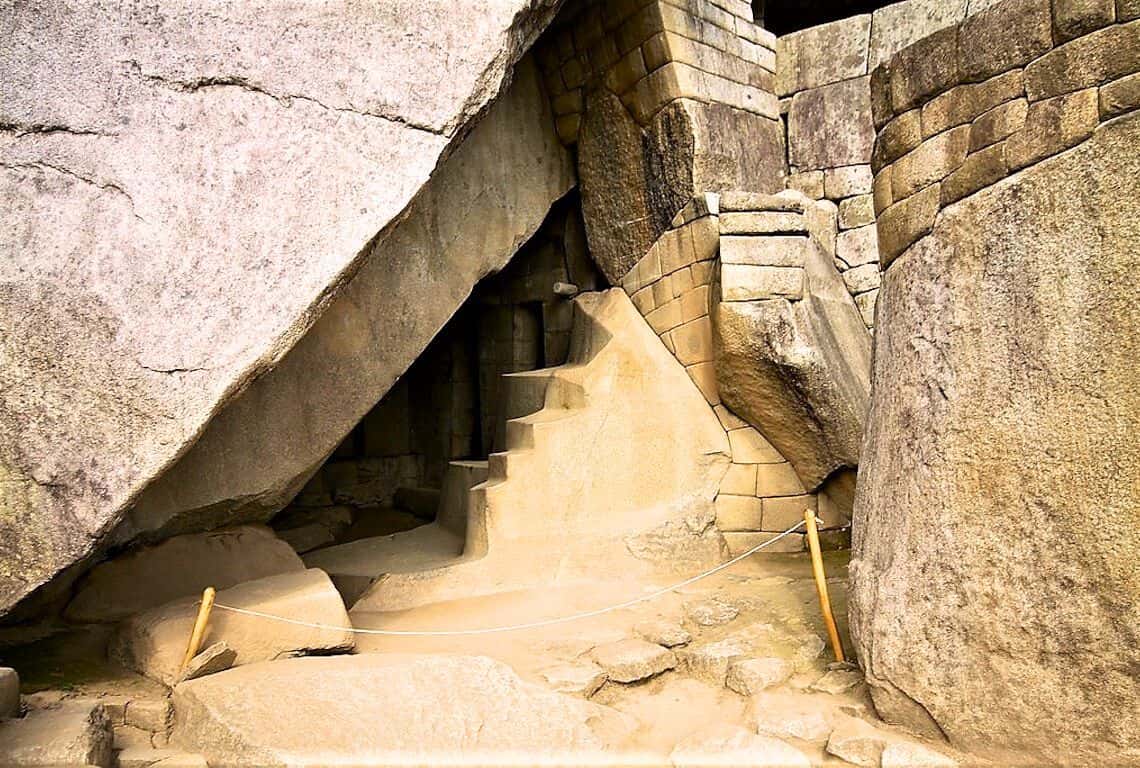
The Royal Tomb / Self-Guided Machu Picchu Tour
The Temple of the Three Windows
The Temple of the Three Windows is one of the largest and most well-preserved buildings on the site
It is a rectangular-shaped building that measures approximately 35 feet by 10 feet constructed from large granite blocks that were precisely cut and fitted together without the use of mortar.
The building has three large windows that face east, each of which is framed by a trapezoidal-shaped stone lintel. The windows are the most distinctive feature of the temple, and they provide a stunning view of the surrounding mountains and valleys.
The temple is believed to have been built during the reign of the Incan emperor Pachacuti in the 15th century. It is thought to have served as a royal palace or a religious center, and it may have been used for important ceremonies or meetings.
The temple’s location in the Sacred Plaza suggests that it was an important site for Incan religious and ceremonial activities.
The temple is also notable for its intricate carvings and decorations, which include a series of zigzagging cornices and decorative friezes that run along the top of the building.
The temple’s walls are adorned with a variety of images and symbols, including snakes, pumas, and condors, which were all important animals in Incan mythology.
One of the most interesting aspects of the Temple of the Three Windows is its alignment with the winter solstice. On the day of the winter solstice, the rising sun shines through the temple’s central window and illuminates a rock inside the building, which is believed to have been a sacred object for the Incan people.

The Temple of the Three Windows / Self-Guided Machu Picchu Tour
The Principal Temple of Machu Picchu
Due to its large size and prominent location on the Sacred Plaza, many archaeologists believe that Principal Temple was one of the main public temples at Machu Picchu, where large ceremonies would have taken place.
Due to soil movement and sinking, one corner of the temple has been damaged. Its huge stone blocks shifted out of place. Nonetheless, it remains an impressive structure.
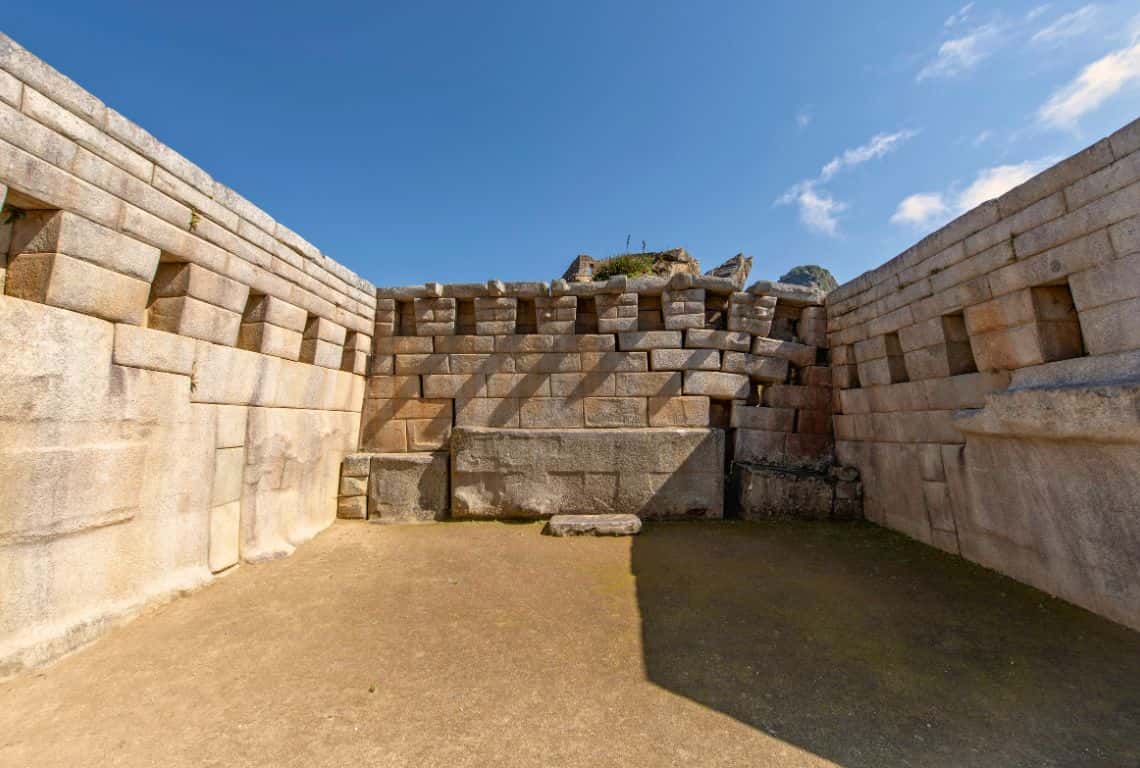
The Principal Temple / Self-Guided Machu Picchu Tour
Intihuatana
Intihuatana is perhaps the biggest puzzle at Machu Picchu. It is also known as the “Hitching Post of the Sun”.
The Intihuatana stone is located in a large, open-air space at the top of a mountain ridge overlooking the city of Machu Picchu. It is made from a single piece of granite that has been precisely carved to form a tall, narrow pillar with a flat top. The pillar is oriented to align with the four cardinal directions and is anchored to the bedrock beneath it.
The purpose of the Intihuatana stone is not entirely clear, but it is believed to have been used for astronomical observations and to mark the changing of the seasons. The Incan people were skilled astronomers, and they used the movement of the sun, stars, and planets to determine important dates for planting crops, holding religious ceremonies, and other activities.
The Intihuatana stone was also thought to have been a sacred object that held great spiritual power. It was believed to have the ability to harness the energy of the sun and to act as a conduit between the physical and spiritual worlds. During important religious ceremonies, priests would tie a rope to the top of the Intihuatana stone and use it as a focal point for their prayers and rituals.
Unfortunately, many of the Intihuatana stones throughout Peru were destroyed by Spanish conquerors during the 16th century, who saw them as symbols of pagan worship. However, the Intihuatana stone at Machu Picchu is one of the few that has survived, and it remains an important and revered object for the modern-day descendants of the Incan people.
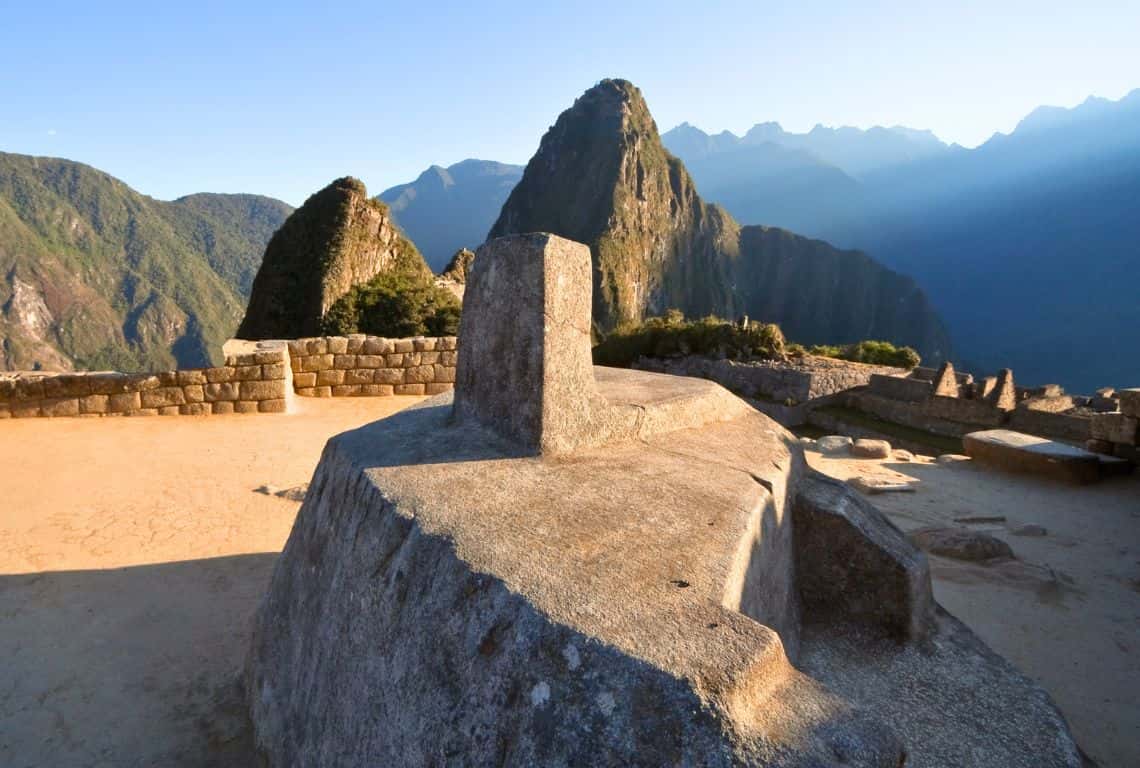
Intihuatana / Self-Guided Machu Picchu Tour
The Temple of Condor
The Temple of the Condor is one of the most unique and impressive structures at Machu Picchu, the ancient Incan city in Peru. It is named for its resemblance to a large condor with outstretched wings.
The temple is built into the natural rock formations of the mountain and consists of two main parts: the lower level, which contains a series of rooms and chambers, and the upper level, which is an open-air space that is shaped like a giant condor.
The upper level of the Temple of the Condor is the most recognizable feature of the structure. It is a large, rectangular space that is bordered by two huge stone walls, each of which is shaped like the outstretched wings of a condor. The wings are so accurately sculpted that they even include the individual feathers and contours of the bird’s wings.
In the center of the space is a large, flat stone slab that is also shaped like a condor. This is thought to have been used as a sacrificial altar during Incan religious ceremonies.
The lower level of the Temple of the Condor consists of a series of chambers and rooms that were likely used for storage or as living quarters for the priests who served at the temple. The chambers are accessible through a narrow passageway that leads from the upper level of the temple.
The purpose of the Temple of the Condor is not entirely clear, but it is believed to have been a site for religious ceremonies.
The condor was a sacred animal in Incan culture and was often associated with the sun god Inti, so it is possible that the temple was dedicated to the worship of Inti or other deities.
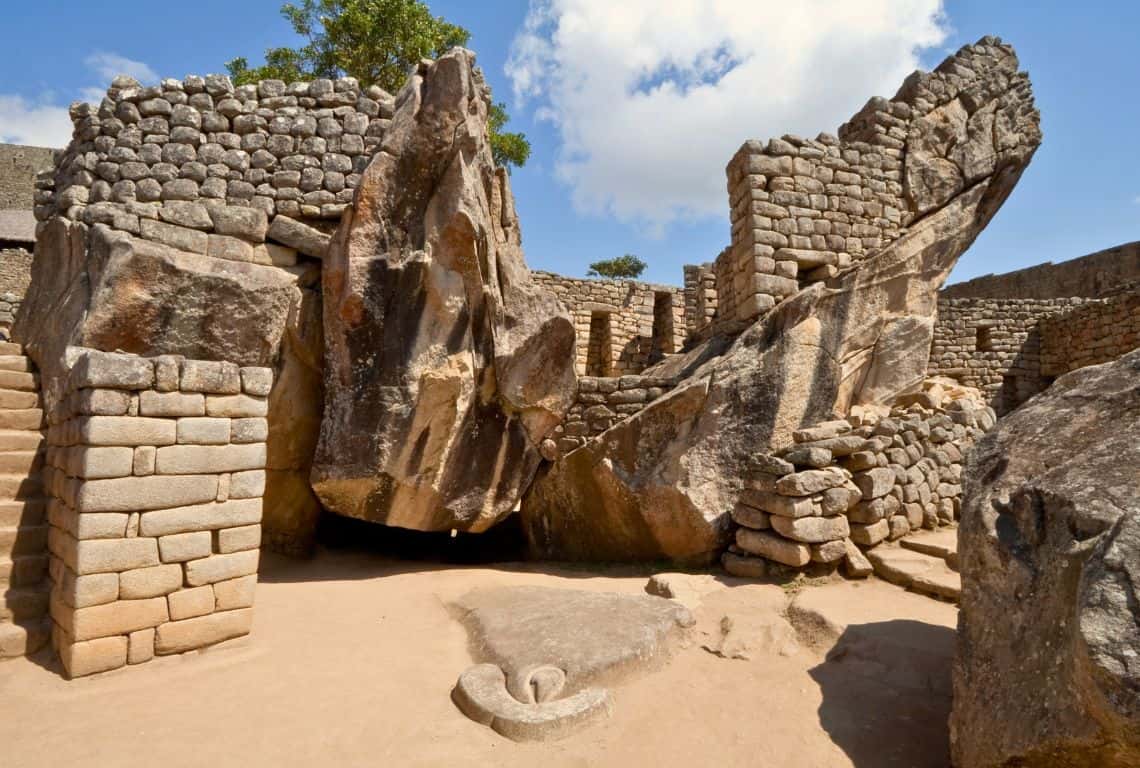
The Temple of Condor / Self-Guided Machu Picchu Tour
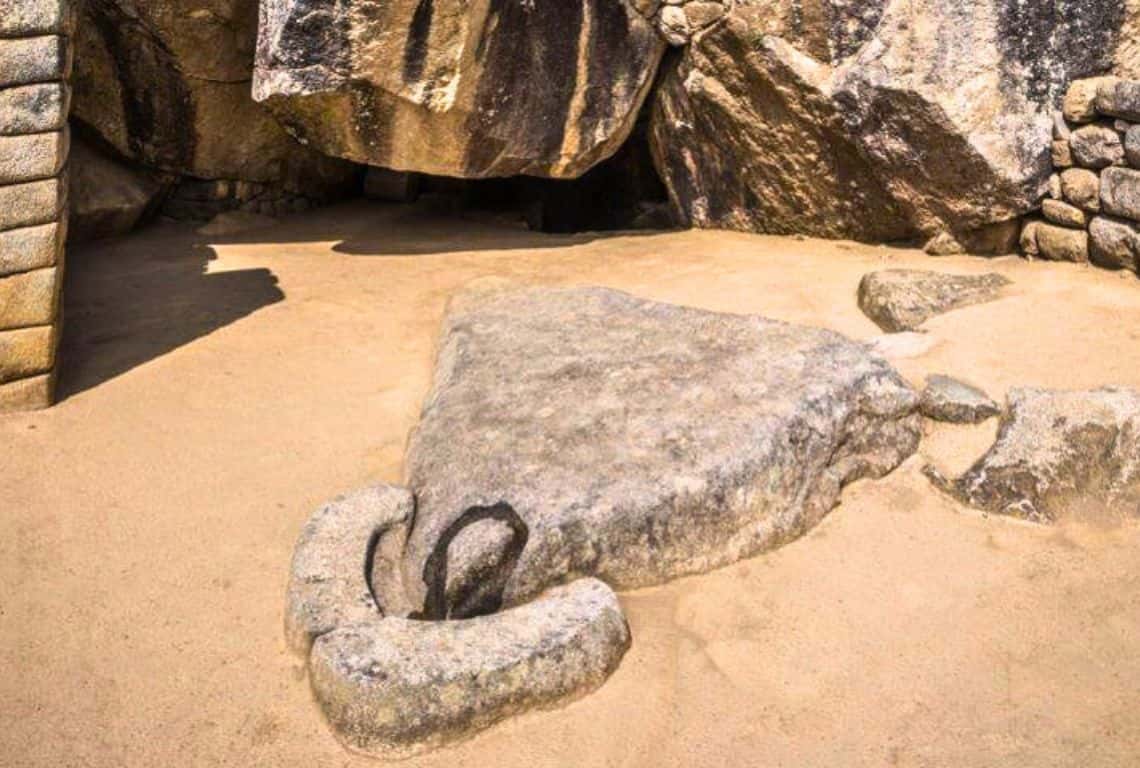
The Temple of Condor / Self-Guided Machu Picchu Tour
The Urban Sector
The Urban Sector at Machu Picchu was the heart of the site, and it is believed that it served as the administrative, religious, and residential center of the citadel.
The Urban Sector is laid out in a grid pattern, with buildings arranged in a series of terraces and plazas. The buildings are oriented to the cardinal points of the compass, and the streets and pathways are lined with stone walls and steps.
The buildings are typically rectangular in shape and feature trapezoidal doorways and niches. You can admire their precise stonework, which was fitted together without the use of mortar.
The roofs of the buildings were made from thatch or wood.
The residential buildings in the Urban Sector are small and simple, and they were likely used to house workers and lower-status individuals. The buildings are arranged in clusters, with small courtyards and narrow passageways between them. These buildings are typically small and consist of one or two rooms. The rooms were used for sleeping and storage and often had niches built into the walls for storing food and other supplies.
The Urban Sector includes a number of fountains and water features, which would have provided the site’s inhabitants with a source of fresh water. The fountains are typically carved from stone and feature designs and carvings.
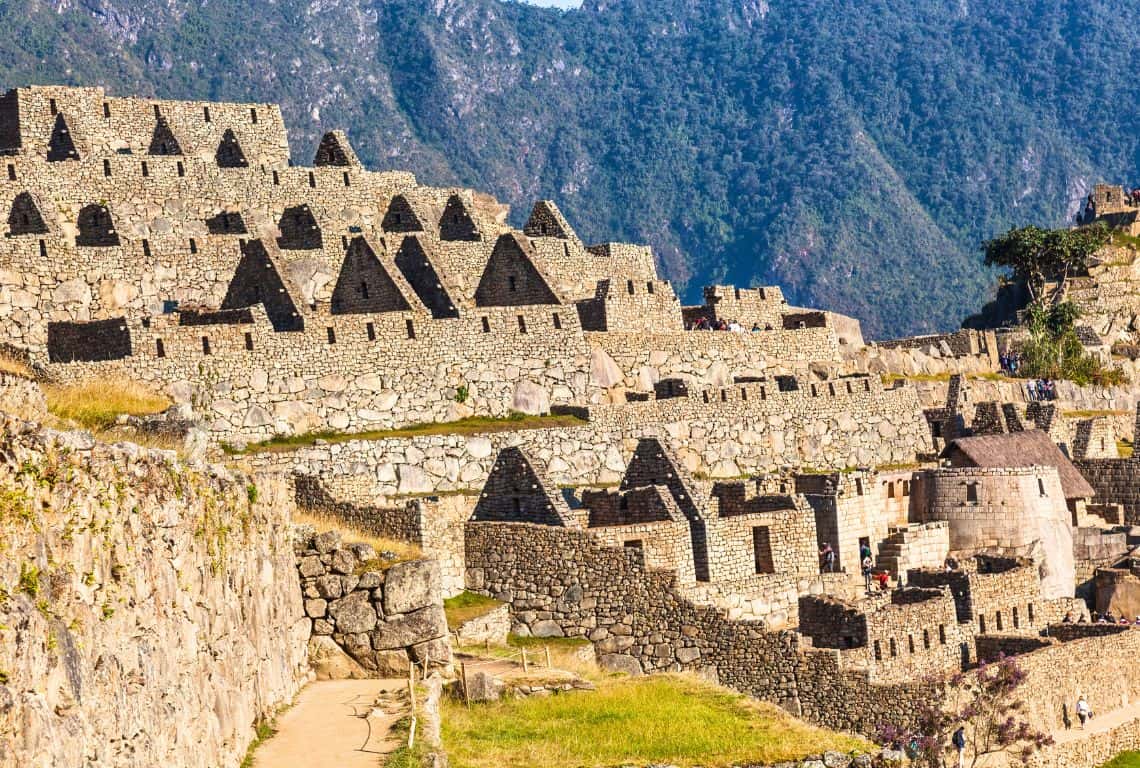
The Urban Sector / Self-Guided Machu Picchu Tour

The Urban Sector / Self-Guided Machu Picchu Tour
The Main Plaza
The Main Plaza at Machu Picchu is a large, open space located at the heart of the ancient Incan city. It is a rectangular-shaped area that measures approximately 30 meters by 25 meters and is surrounded by several important structures, including the Temple of the Three Windows, the Sacred Plaza, and the Intihuatana.
The purpose of the Main Plaza at Machu Picchu is believed to have been primarily ceremonial. It was likely used for important events such as religious ceremonies, civic gatherings, and military parades. The Inca Empire was known for its elaborate religious rituals, and many of these would have taken place in the Main Plaza.
In addition to its ceremonial function, the Main Plaza may have also served as a marketplace where local vendors could sell their goods to residents and visitors alike.
It is also possible that the Plaza was used for sporting events, such as the traditional Incan game of Tlachti, which involved a rubber ball and two teams trying to score points by hitting the ball through stone hoops.
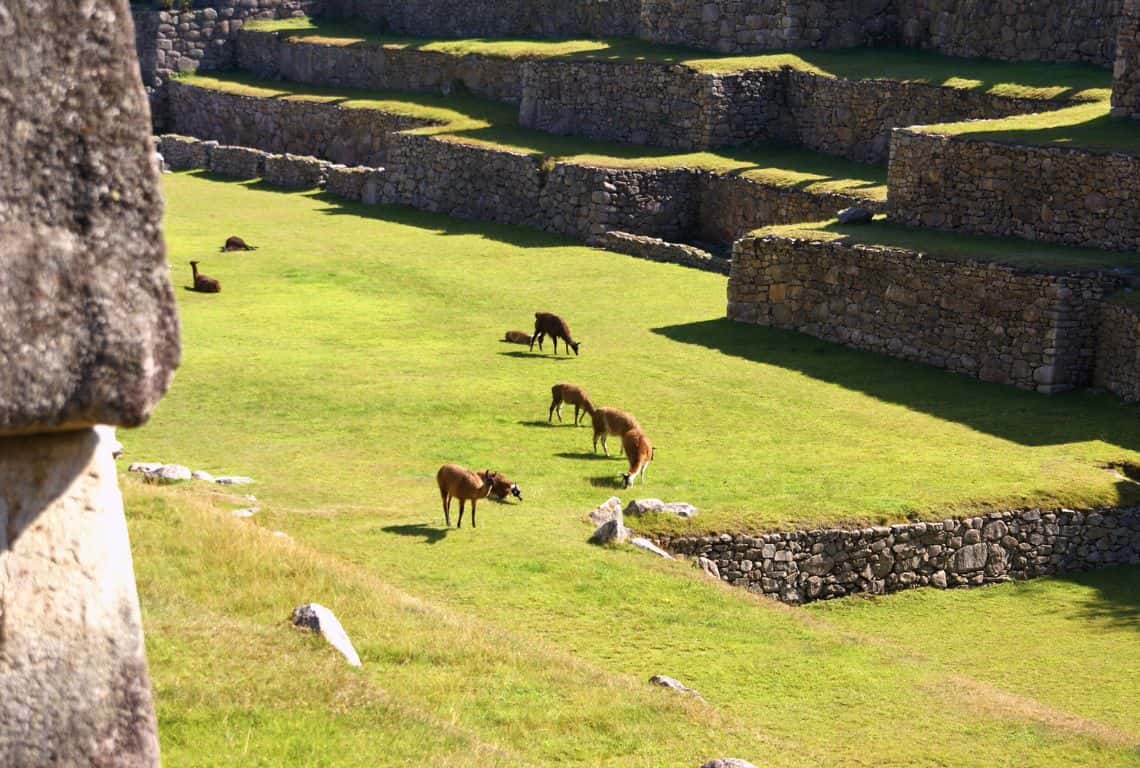
The Main Plaza / Self-Guided Machu Picchu Tour
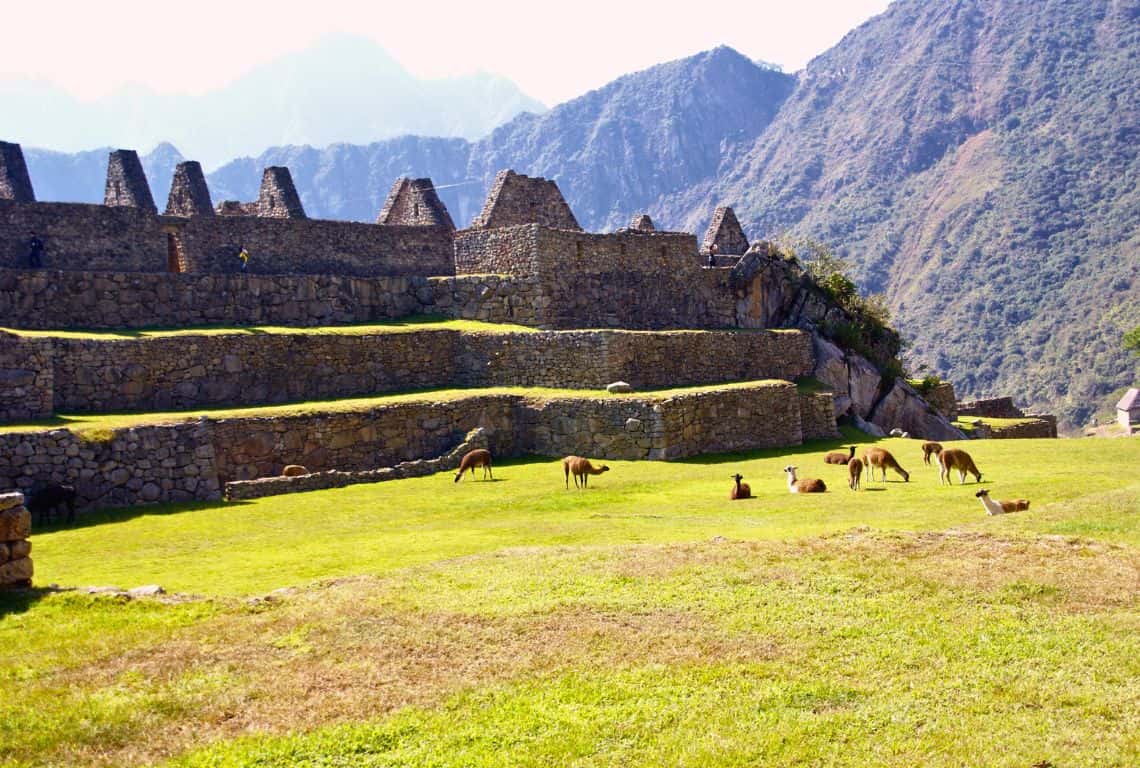
The Main Plaza / Self-Guided Machu Picchu Tour
Intrepid Scout's Tips on Self-Guided Machu Picchu Tour
- Buy your tickets in advance and online at the Peru Ministry of Culture website.
- Bring your passport and entrance ticket. Make sure the name on your passport matches exactly the name on your ticket.
- Get to Machu Picchu for sunrise. It is a magical experience.
- Pay extra and hike to either Huayna Picchu or Montana Machu Picchu.
- Use the bathroom before you go in. There are no bathrooms at the site.
- Bring water in a reusable container. Plastic bottles are not allowed.
- Dress in layers and bring a poncho. The weather is unpredictable at Machu Picchu.
- Do not bring large backpacks. You will have to store them in lockers. Carry a daypack only.
- Plan your return trip accordingly. Lines start forming at about 3 pm and it might take up to 40 minutes to get on the bus.
More Helpful Posts About Peru:
HIKING to Machu Picchu from Aguas Calientes, Peru (Step-by-Step Guide)
7 Coolest Day Trips from Cusco, Peru (with Maps and Photos)
15 Terrific Things to Do in Lima, Peru (+ BONUS: Complete Guide to Lima)
Amazing 2 Days in Cusco (Explore Cusco’s Cultural Treasures)
7 Fun and Cool THINGS to DO in AGUAS CALIENTES (Besides Machu Picchu)
Cusco to Maras Salt Mines: 6 Things to Discover in Sacred Valley’s Natural Wonder
Did You Find Self-Guided Machu Picchu Tour Useful?
Why Not Save It to Your Pinterest Board!
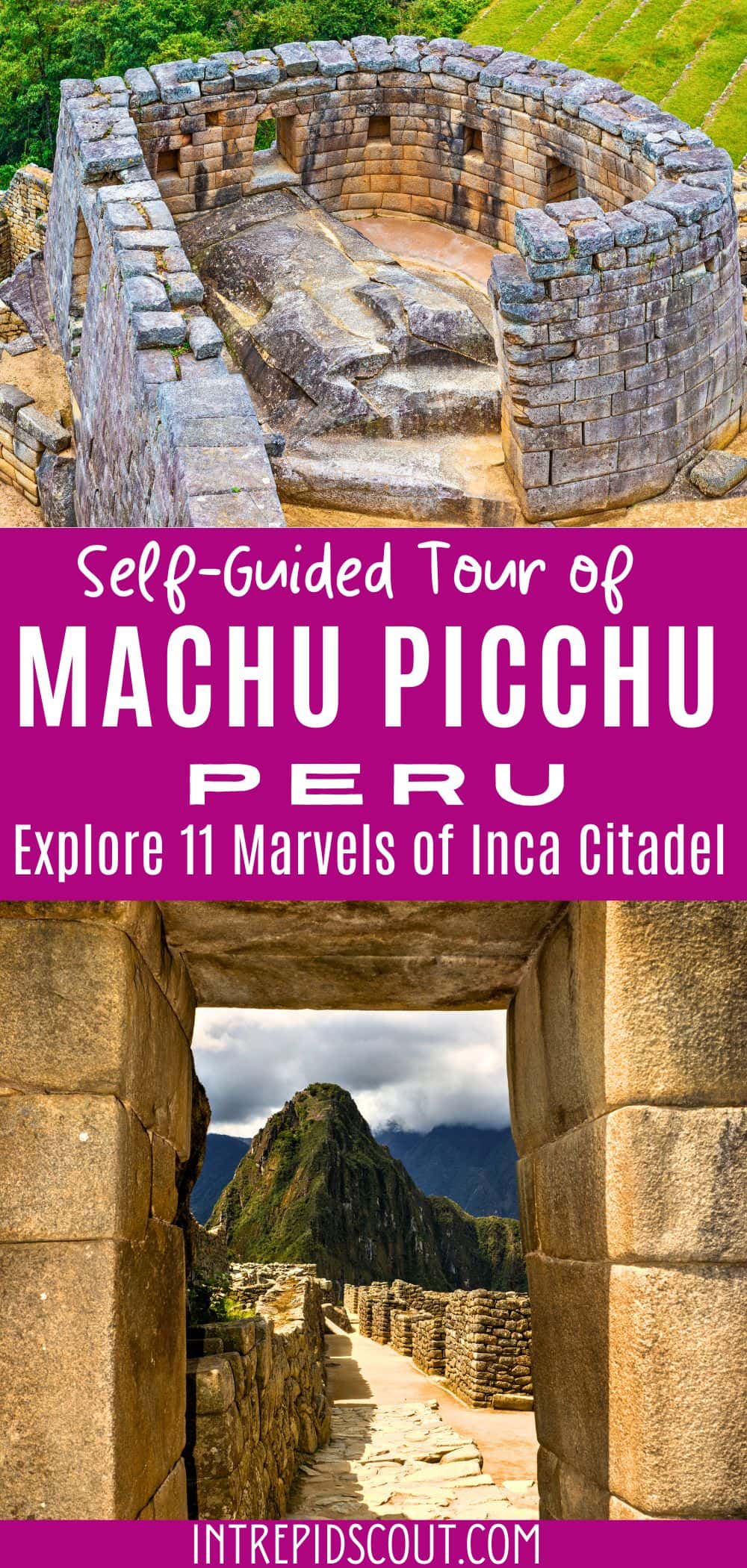
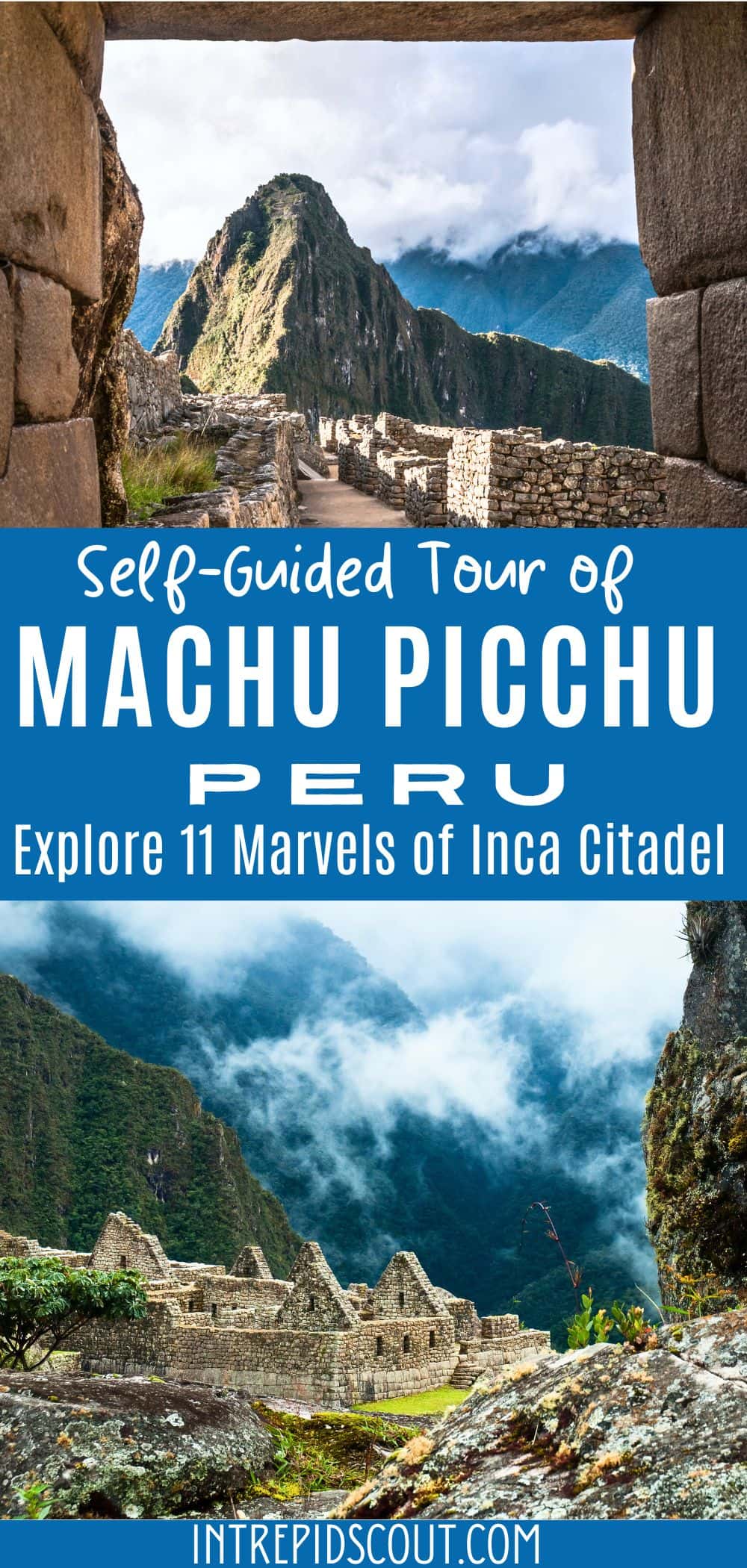
Now, It Is Your Turn, I Would Like to Hear Back from You!
Are you planning your trip to Machu Picchu?
Please let me know! Drop me a quick comment right below!
Click on any of the images below to get inspired and to help you with the planning process for your trip to Peru!
